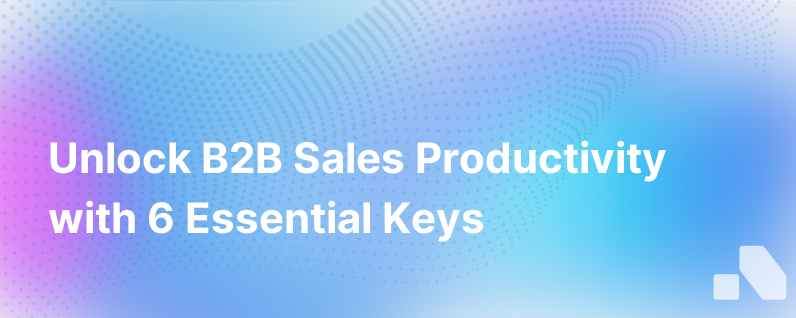6 Keys Increase B2B Sales Productivity
Published on December 28, 2023 by David Zhang
Increasing B2B sales productivity is like finding the perfect rhythm in an orchestra. Each element, from the instruments to the musicians, must align perfectly to produce a harmonious outcome. For B2B sales, this translates to a well-orchestrated combination of strategy, tools, and tactics designed to maximize efficiency and results.
In the B2B realm, where the sales cycle is often long and complex, productivity isn't just about working harder; it's about working smarter. By focusing on the right activities and empowering your sales teams with the best tools and information, you can not only increase productivity but also drive better sales outcomes.
Here are six keys to unlocking higher B2B sales productivity:
1. Arm Your Sales Team with the Right Tools
Digital transformation isn’t just a buzzword; it’s a necessity in today’s B2B sales landscape. The right sales tools can slash administrative burdens and give reps more time to spend on customer-facing activities. Investments in customer relationship management (CRM) systems, automation tools, and intelligence platforms like Aomni can offer dramatic improvements in productivity.
2. Emphasize Sales Training and Onboarding
Knowledge is power in sales. A well-trained sales team is one that can spot opportunities, understand customer pain points, and effectively communicate the value proposition. Ensure your onboarding process is comprehensive and provides ongoing training opportunities that encompass product knowledge, industry trends, and sales techniques. Create a culture of learning that encourages continuous improvement and sharing of best practices.
3. Implement Strategic Activity Management
Every action your team takes should serve a strategic purpose. By aligning daily activities with overarching goals, you'll ensure efforts aren't wasted on low-yield tasks. This requires a deep understanding of the sales funnel and the ability to identify activities that move the needle. Use data to pinpoint which activities result in conversions and prioritize those. Activity management tools can help track and measure success to inform future strategies.
4. Streamline Communication and Collaboration
Effective internal communication can significantly reduce time wasted on misunderstandings or duplicated efforts. Leveraging collaboration platforms can create more fluid communication between sales, marketing, product development, customer service, and even customers themselves. When information is shared and accessible, it reduces the time needed for back-and-forth communication and ensures everyone is working from the same playbook.
5. Leverage Data and Analytics
Data-driven decision making leads to efficient and productive sales activities. By analyzing customer data and sales metrics, your team can tailor their approach, personalize their conversations, and target prospects at the right time with the right message. Moreover, predictive analytics can inform you which leads are the hottest, so your sales team doesn’t spend valuable time on prospects who are less likely to convert.
Invest in sales analytics tools that provide real-time insights into performance, pipeline health, and forecasting. This not only helps in improving productivity but also ensures better predictability and accountability within your sales operation.
6. Encourage a Customer-Centric Mindset
Finally, infusing a customer-centric mindset at the core of your sales strategy ensures that your team is focusing on building relationships, not just closing deals. Understanding the customer journey and tailoring the sales process to meet customers where they are can yield larger deals and shorter sales cycles.
Sales productivity increases when reps spend more time providing value to prospects and less time on tasks that don't directly contribute to relationship building. Therefore, centering operations around customer needs, challenges, and outcomes is crucial to increasing B2B sales productivity.
Wrapping Up
By focusing on these six areas, B2B sales organizations can hone their approach, optimize their time, and ensure that their efforts contribute to the goal of building more significant and better business relationships.
When your sales team is equipped with the right tools, trained and onboarded effectively, engaged in high-value activities, and utilize data and a customer-centric approach, productivity will naturally rise. Moreover, collaboration platforms can facilitate the kind of teamwork required to manage complex sales and buyer journeys effectively.
With the integration of platforms like Aomni, sales teams now have the means not only to access critical account data in real-time but also to generate actionable competitive insights and personalized sales content, further unlocking productivity. In this new age of B2B sales, being productive doesn't necessarily mean doing more; it's about doing things more intelligently, effectively, and, whenever possible, automatically.
Boosting sales productivity is not a one-time fix but a continuous journey of refinement. The needs and behaviors of B2B buyers are ever-changing, and so should your sales productivity strategies. Adapting to these changes and enhancing your sales processes with the guidelines highlighted above is key to staying competitive and top-of-mind with your B2B clients.